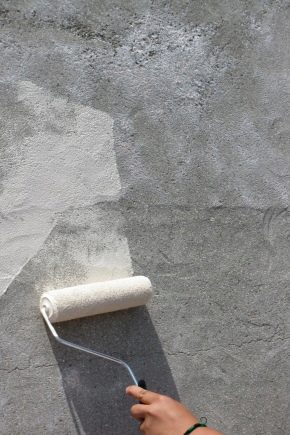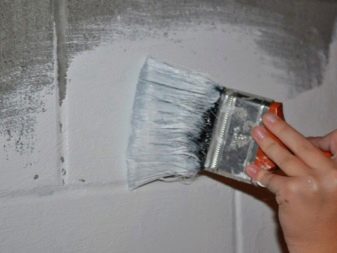Which paint to choose for concrete surfaces?

It is difficult to imagine building without the use of concrete. Foundations, floor screeds, walkways, stairs, floor slabs are just a few of the uses for this building material. It is associated with something durable and reliable, but few know that without some protective measures, concrete quickly succumbs to destruction.


Coating features
The need for additional protection is dictated by the characteristics of the concrete pavement.
First, it is worth noting the positive aspects of this coverage:
- The popularity of concrete is not diminished due to its durability and strength: sealed and properly treated floors or walls can last almost forever. The strength of concrete is, in principle, a variable indicator, because it grows as it hardens and does not stop when the standard period of 28 days is reached.
- Concrete can withstand heavy loads without deformation and destruction.
These qualities make it especially in demand in industrial buildings and the construction of utility facilities (warehouses, garages, etc.).


- Ease of maintenance is another nice bonus of concrete surfaces. It is enough to timely renew the protective layer every 3-9 months, depending on the product used.
- Environmental friendliness also adds points to this material.
- Concrete has less radioactivity than brick. But purely theoretically, concrete components can be contaminated, so you should choose trusted manufacturers and check the documents for the goods.
- Being a versatile material, concrete can be used as a stand-alone surface or as a base for decorative coatings.

For all its positive qualities, concrete, however, is prone to corrosion., in the process of which the structure of the material is destroyed. The main enemy is water, which easily penetrates into the pores of the coating, dissolves and flushes out readily soluble components (hydrated lime). Excess moisture is especially harmful at low temperatures. Freezing water mechanically destroys the bond between the components, which affects the strength.
An acidic environment is no less harmful, as it can cause both leaching of lime compounds and contribute to the formation of insoluble calcium salts, which, accumulating, increase the volume of concrete and provoke cracking. One more factor should be mentioned - biological.
The porous structure of concrete is attractive to microorganisms, and the products of their vital activity are destructive to it.
Protection in several stages allows to neutralize negative impacts. Primary protection consists in the introduction of stabilizing and sealing substances into the mixture, which slow down the action of aggressive reagents. Secondary protection consists in the application of paints and varnishes, primers, mastics and other minor materials.


Types of paint
There is no shortage of paints and varnishes for concrete today, and the options differ in composition and properties. The only question is quality and compliance with operating conditions.
Alkyd paint
Alkyd paint is a type of enamel paint that, after hardening, forms a strong and elastic film on the surface. It is universal, suitable for almost any surface: wood, metal, concrete.
High resistance to weathering, water repellency and resistance to temperature extremes (from -50 to 60 ° C) make it suitable for outdoor use. Equally easy to apply with brush, roller and spray. Drying time is average: about 24 hours. Alkyd enamel applied in 2-3 layers retains its protective properties for up to five years. Another significant plus is the low cost.
Of the minuses, it should be noted its toxicity in a liquid state., flammability and airtightness. Excellent adhesion to the surface makes it difficult to remove. All existing washes only soften the coating, which is then removed with a spatula.


Acrylic paint
Acrylic paint is one of the universal favorites in the building materials market and is an aqueous dispersion based on acrylic resins. When it dries, a polymer film is formed on the surface, which, unlike alkyd-based dyes, easily permits air.
The paint forms a wear-resistant, water-resistant, heat-resistant, non-combustible and environmentally friendly coating. It is completely non-toxic and odorless, since it contains no organic solvents.
Easy to apply and dries within hours. As a rule, the second coat can be applied after 2 hours.
It can be used at high and low (but not below zero) temperatures. It is advisable to make at least two layers. A wide variety of colors and textures of this option allows you to solve any design problem.


Silicate paint
Silicate paint is a type of mineral dyes, the main binding element of which is liquid potash glass, which gives the finish coat high strength. Silicon powder, zinc or aluminum acts as additional components that improve the properties of the material. The presence of these metals increases the anti-corrosion properties of the dye. Liquid glass and dry pigment mixture are supplied separately and are connected immediately before use.
It is one of the most durable coatings (can last at least 20 years), while maintaining its original appearance during the entire period of operation. It is resistant to ultraviolet light, sharp temperature fluctuations, moisture and dirt, and is distinguished by chemical resistance.

This paint and varnish material forms the most durable bond with mineral-based surfaces (concrete, stone, glass, plaster). Often used for facades and other outdoor applications.
Among the minuses, it is worth noting the inelasticity of this dye, that is, small cracks cannot be repaired. Therefore, the base must be ideally prepared. The high toxicity of the paint requires the mandatory use of personal protective equipment. Bond strength is likely to create problems when removing silicate enamel.

Silicone emulsion paint
Silicone emulsion paint is almost close to ideal. When solidified, a waterproofing, vapor-permeable film is formed, which maximally protects the base from moisture. Plus, it is elastic, durable, wear-resistant, and also adheres well to concrete and other mineral substrates. Resistance to an alkaline environment allows it to be applied to concrete and plaster after two days, while acrylic paint can be used no earlier than a month later. The only drawback is the high cost.
The ability of silicone-based resins to bond well with acrylic polymers has resulted in a new group of silicone-modified paints.They are characterized by better properties than classic acrylic, but the price is lower than that of silicone options.



Rubber paint
Rubber paint is a relatively new type of paints and varnishes that has gained a reputation for durable and durable enamel. In a liquid state, it looks like a mastic, which, when dried, forms a film resembling rubber. It contains acrylate latex, which gives elasticity and strength to the composition.

Ordinary water acts as a solvent, which speaks of the environmental safety of the product. The paint is characterized by good adhesion to various types of surfaces, including concrete, plastic, metal, wood. She is not afraid of temperature fluctuations: all properties remain in the range from -50 to +60 C.
Rubber paint can be applied in any way. Some manufacturers produce it in cans. Drying is very fast: after 2 hours the surface is ready for further work.
The rubber film has an anti-slip effect.
Elasticity and flexibility allows it to change along with the base without breaking the integrity. Acrylate latex paint is often used as an additional waterproofing agent, for example, in the construction of swimming pools. Resistance to mechanical stress allows it to be used for applying road markings (preferably using reflective), for finishing playgrounds, stadiums, gyms. The service life is 8-10 years.


Polyurethane paint
Polyurethane paint for concrete surfaces is most often used as a floor paint. The thick elastic film, which forms after curing, effectively protects the floor from mechanical, chemical and atmospheric influences. Polyurethane paints are available as one-component and two-component paints. The latter option is more common and is sold in two containers. One comes with hardener and the other contains resin.

A distinctive feature of this type of paints is the ability to apply at temperatures from -10 to +30 C and at high humidity. Moreover, moisture is one of the conditions for solidification of this material. Service life - from 10 years.
Epoxy enamel
Epoxy enamel is a two-component paint based on epoxy resins. Today it is considered one of the most durable and wear-resistant coatings. Depending on the type of resins and their proportions with hardeners, formulations with different properties are obtained: from rigid to flexible. Epoxy based paints are versatile and adhere firmly to all types of surfaces.
Among its analogues, it is distinguished by resistance to influences of any orientation: chemical, atmospheric, mechanical, biological. The epoxy coating retains its original appearance throughout its entire service life. The only drawback is its two-component nature. When mixing components, it is easy to make a mistake in proportions, which will not allow you to get the desired result.


How to choose?
For concrete paints, the following characteristics are important:
- Resistance to mechanical damage;
- Wear resistance;
- Refractoriness;
- Heat resistance;
- Waterproof;
- Chemical resistance;
- Lack of a pungent odor;
- Environmental Safety;
- Easy to care for.



Unfortunately, the ideal product that equally combines all these qualities has not yet been invented. Therefore, the choice depends, first of all, on the purpose of the premises. Before going to the store, it is worth assessing the intensity of use of the concrete surface. For example, paint requirements for a garage floor will be higher than for a similar material for a window sill, balcony or wall.
When choosing a paint, you also need to keep in mind the type of work:
- For interior work, non-toxic and environmentally friendly compositions are appreciated. The absence of a pungent smell will also be a plus, since it will allow painting poorly ventilated rooms without problems.The durability of the dye in the case of interior decoration will be important for industrial premises and large trade areas where there are high mechanical loads on the floor.


- For exterior finishes, the toxicity index is not decisive. It is important here that the finishing material is resistant to all kinds of influences: physical, chemical and biological.
- On the positive side, many of the products on the market are versatile. Therefore, before buying, you need to carefully study the product labeling, its composition, properties and recommendations for use.
Tips & Tricks
An important condition for the successful painting of concrete, however, like other surfaces, is preparatory work. At this stage, dust, dirt, paint residues, grease stains are thoroughly removed. When re-staining, it is advisable to walk with a sander to remove the destroyed top layer. Examine the treated area for defects, remove the detected violations. Concrete itself has low adhesion (especially for low-quality grades), therefore, for better adhesion to the finishing material, it is treated with primer paint.

Famous manufacturers and reviews
Among paints and varnishes for concrete, polyurethane paint is heard "Texil"... Almost all customer reviews are positive. It came as a surprise to users that, at a relatively low price, they received a durable coating with good performance.


Polymer acrylic floor paint "Betoxil" - another good brand for industrial and civil use.
Strong and durable, it is suitable for painting at low and even negative temperatures.


Finishing material of the brand "Aquapol" used in facilities where normal or medium load is expected. Suitable for rooms with high humidity.


"Elakor" Are polyurethane paints that can be either one- or two-component. They are approved for use in food and pharmaceutical industries, as well as in residential premises.

How to paint a concrete surface on the street, see the next video.













Very interesting article! Thanks.
The comment was sent successfully.